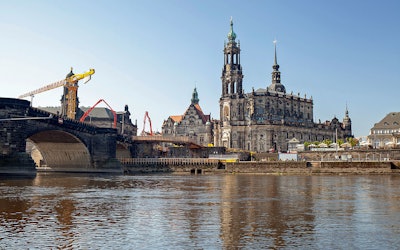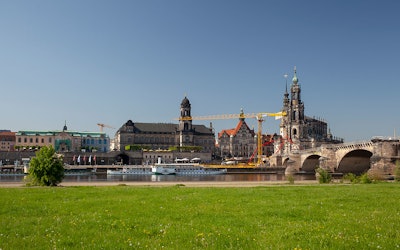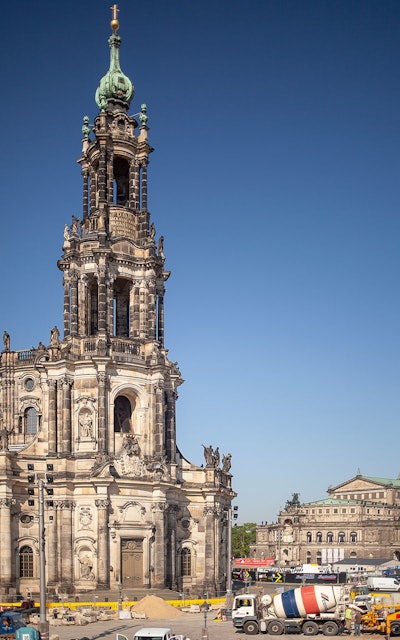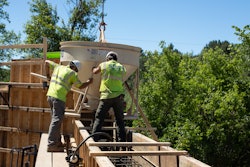
CEMEX Germany is using an innovative and customized light-colored ready-mix concrete to restore the 289-year-old Augustus Bridge over the river Elbe in Dresden, Germany. In addition to fulfilling historical standards by preserving the color and surface texture of the bridge’s original material, the concrete is designed to ensure the bridge’s structural integrity as well as comply with the visual consistency of the other historical pieces of architecture and infrastructure in the region.
The City of Dresden, represented by the Road and Civil Engineering Authority, the Dresden public transport services and various utility companies, is currently renovating the bridge in accordance with the protection of historical monuments. The renovation is necessary following a series of incidents that have damaged the structure, including a flood in 2013.  CEMEX Germany supplied around 4,000 cubic meters of ready-mix concrete, 500 meters of which was colored concrete.CEMEX Deutschland AG/Sebastian Lechler
CEMEX Germany supplied around 4,000 cubic meters of ready-mix concrete, 500 meters of which was colored concrete.CEMEX Deutschland AG/Sebastian Lechler
The project’s primary contractor, Hentschke Bau GmbH of Bautzen, is using approximately 4,000 cubic meters of concrete from CEMEX Germany. Concreting work began in April 2017, and is expected to be completed by Spring 2020. The renovation includes the total replacement of one of the bridge’s arches at the Old Town abutment above the riverside road, Terrassenufer, which has been completed. Each of the bridge’s arches and piers will be equipped with reinforced concrete slabs as a basis for a new waterproofing system. In addition, all visible surfaces made of sandstone will be extensively repaired.
In order to maintain the historical integrity of the bridge, CEMEX Germany developed a custom, light-colored concrete that exactly matches the original color and style of the bridge. Created by CEMEX’s ready-mix technologists, the customized concrete is being used for both the new construction of the arch at the Old Town abutment as well as the restoration and reinforcement of all the other arches and piers. The customized color was developed by mixing yellow and red pigments with limestone chippings, limestone powder and a special binder that ensures the required strength of the bridge with the added feature of reduced heat generation, which is critical in historical restorations. At 561 meters, the bridge was the longest stone arch bridge in Europe at the time it was constructed.CEMEX Deutschland AG/Sebastian Lechler
At 561 meters, the bridge was the longest stone arch bridge in Europe at the time it was constructed.CEMEX Deutschland AG/Sebastian Lechler
“The greatest challenge in terms of concrete technology is the restoration of the arch over the Terrassenufer, since the concrete for that section must have the same appearance as the historic concrete from 1910,” explains Uwe Engelhardt, Area Manager, Ready-Mix Concrete, Saxony, CEMEX Germany. “The construction site is particularly challenging due to its unique location against the backdrop of Dresden’s historic Old Town, with the bridge as a central location in the city.”
The current iteration of the bridge was built around 1730 by Augustus II the Strong. It underwent a renovation between 1907 and 1910 to align with then-current structural engineering requirements and was completely redesigned during that same period as a series of three-hinged concrete arches. The visible surfaces of the nine arches and eight piers were clad in sandstone. Tamped concrete forms the core of the massive arched bridge.
The bridge spans the river Elbe between the old and new towns of Dresden at a spot along the river where there has been a crossing since the 12th century. At 561 meters, the bridge was the longest stone arch bridge in Europe at the time it was constructed. Augustus II the Strong had the Bridge extensively rebuilt in the baroque style. The bridge is widely considered the most beautiful bridge in Europe.


![Fcp Racatac Chair 10893876[1]](https://img.forconstructionpros.com/mindful/acbm/workspaces/default/uploads/2025/10/fcp-racatac-chair-108938761.10l0At5WXv.png?auto=format%2Ccompress&bg=fff&fill-color=fff&fit=fill&h=100&q=70&w=100)








![Fcp Racatac Chair 10893876[1]](https://img.forconstructionpros.com/mindful/acbm/workspaces/default/uploads/2025/10/fcp-racatac-chair-108938761.10l0At5WXv.png?ar=16%3A9&auto=format%2Ccompress&bg=fff&fill-color=fff&fit=fill&h=135&q=70&w=240)








